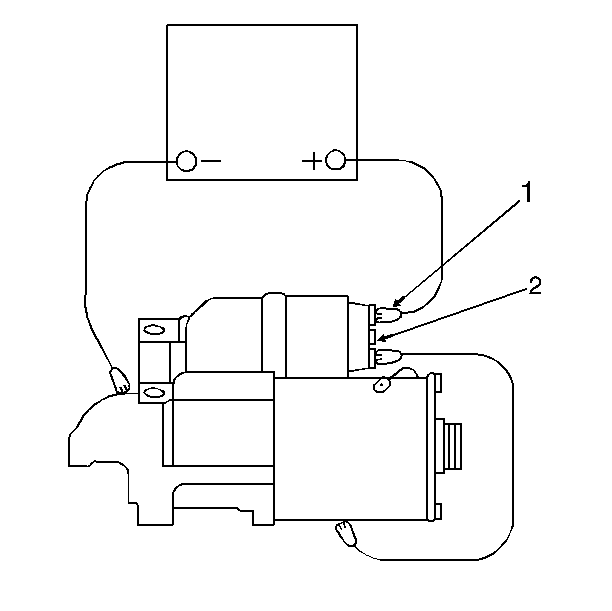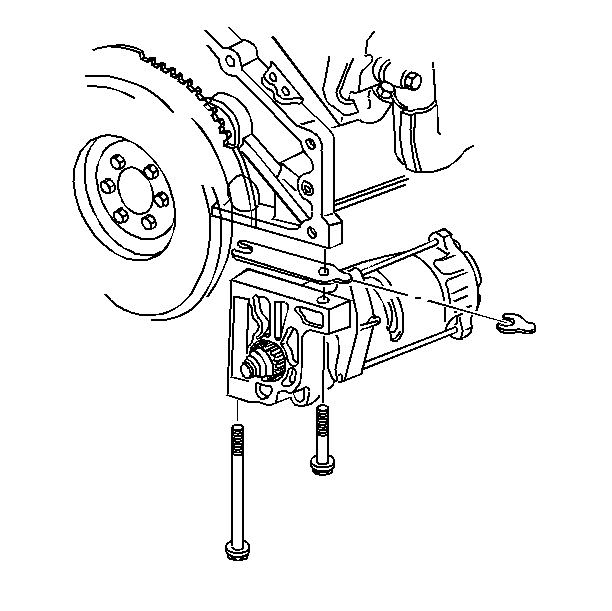Removal Procedure
- Disconnect the negative battery cable. Refer to
Caution: Unless directed otherwise, the ignition and start switch must be in the OFF or LOCK position, and all electrical loads must be OFF before servicing any electrical component. Disconnect the negative battery cable to prevent an electrical spark should a tool or equipment come in contact with an exposed electrical terminal. Failure to follow these precautions may result in personal injury and/or damage to the vehicle or its components.
in General Information. - Raise the vehicle. Refer to Section 0A.
- Support the vehicle with safety stands.
- Disconnect the following leads from the starter motor.
- Remove the starter motor mounting bolts.
- Remove any shims.
- Remove the sealer.
- Remove the starter motor.
Caution: Keep fingers, tools, and any other objects away from the opening in the drive end housing while making electrical connections. The strong shifting action of the starter solenoid can cause severe personal injury or damage to components as the drive pinion moves into the cranking position.
Notice: Do not crank the starter motor for more than 30 seconds at a time. Cool for at least two minutes after cranking before continuing. Excessive cranking can cause serious damage to the starter motor as well as erroneous test results.

| • | The positive battery cable (1) |
| • | The S terminal (2) |
Important: Support the starter motor before removing the mounting bolts.

Installation Procedure
- Position the starter motor on the vehicle.
- Install any shims, if removed.
- Install the starter motor mounting bolts.
- Install the sealer on the front of the starter motor.
- Connect the positive battery cable to the starter motor (1).
- Install the positive battery cable to starter motor nut.
- Connect the S terminal lead to the starter motor (2).
- Lower the vehicle.
- Connect the negative battery cable.
Caution: Keep fingers, tools, and any other objects away from the opening in the drive end housing while making electrical connections. The strong shifting action of the starter solenoid can cause severe personal injury or damage to components as the drive pinion moves into the cranking position.
Notice: Do not crank the starter motor for more than 30 seconds at a time. Cool for at least two minutes after cranking before continuing. Excessive cranking can cause serious damage to the starter motor as well as erroneous test results.

Tighten
Tighten the starter motor mounting bolts to 47 N·m (35 lb ft).
Notice: Use the correct fastener in the correct location. Replacement fasteners must be the correct part number for that application. Fasteners requiring replacement or fasteners requiring the use of thread locking compound or sealant are identified in the service procedure. Do not use paints, lubricants, or corrosion inhibitors on fasteners or fastener joint surfaces unless specified. These coatings affect fastener torque and joint clamping force and may damage the fastener. Use the correct tightening sequence and specifications when installing fasteners in order to avoid damage to parts and systems.

Tighten
Tighten the nut to 14 N·m (10 lb ft).
Tighten
Tighten the S terminal lead nut to 4 N·m (35 lb in).
Tighten
Tighten the negative battery cable to 15 N·m (11 lb ft).
